Connie Reeder Nichols's Blog
June 7, 2025
The Intersection of Ritual and Consciousness

Oshen
DETERMINING THE NATURE of an ecstatic experience during the ritual of any mystical religion seems subjective and unreachable. But some common parallels in these rituals do exist with a broad stroke.
Disclaimer: I have visited Cuba, published about Cuba (EQ 1999)
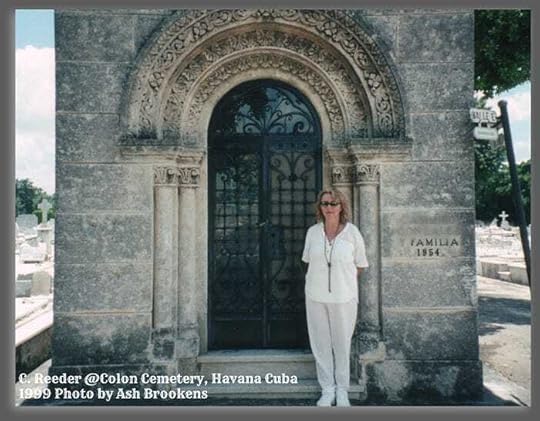 Author @ the Colon Cemetery, Havana Cuba 1999
Author @ the Colon Cemetery, Havana Cuba 1999and lived years in Miami, NYC and New Orleans, cities with large numbers of Afro-Caribbean people. I’ve also been exposed to some of the Santería/Vodoun rituals and icons, but I cannot speak in the first person about Santería possession or trance. However, credible authors such as Maya Deren and Joseph Murphy shared their close experiences with possession, providing a small window.
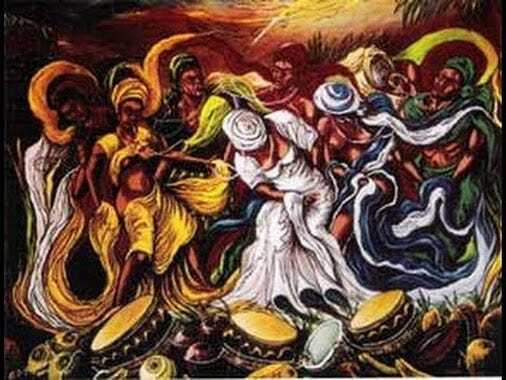
7 African Powers
Are metaphysical encounters, ritualistic or otherwise, merely the by-product of brain synopsis or is there a region outside of our solid awareness, a dimension that our bodily senses cannot easily detect, and could this region be shared by all humans, a realm in which any person from any race or ethnicity can access under the right circumstances?
The religion of Santería or the way of the saints, also called Regla de Ocha, was constructed by West African priests/priestesses kidnapped by slavers, since among many other similarities, the liturgical language is a dialect of Yoruba or Lucumí, a language of West Africa, specifically Nigeria. (1) In the Caribbean, the African religion hid behind the saints inside the Catholic Church foisted on the slaves. Enslaved Africans noted the similarities of their native gods or orishas from their African homeland with that of the Catholic Saints.
The orishas were paired (hidden) behind their Catholic counterparts. Elegguá embodies St. Anthony — fate and justice; Orúla embodies St. Francis of Assisi — divination or wisdom; Changó or Shangó embodies St. Barbara — passion or power or thunder; and Oshún embodies Our Lady of Charity or Caridad (Cuba) — eros or love, marriage and gold. Each orisha is associated with its own color and number.

Oshún’s Altar
For example, Oshún’s color is yellow and responds to the number five (Murphy 43). Africans in slavery kept their Orishas alive in their hearts and minds, along with their ancestor rituals, which are seemingly the foundational rituals. According to one Santeria church , “if we stand tall it is because we stand on the shoulders of our ancestors and are reaching for the orishas.”
Joseph Campbell talks about a “fifth dimension” where people experience a bliss or “Earthly Paradise,” even though in the physical world this same blissful person may seem to another observer as “a squalid heathen in a shattered hut” (Deren xii). So, it is all about perception, once again: personal space or fifth dimension? (The vote is out as to whether there is even a 4th dimension, so beware of anyone with so-called facts.) And, where is this other, extra-dimensional space, next to our own or is it simply in our heads, in a room of our own personal space? Whether or not a god appears in this “fifth dimension,” incorporating separately from human consciousness, is entirely another, improvable matter to the scientific community that demands a tangible proof untenable to measure with current technology.
The other choices in this dithering around the sacred are the obvious sneers from the peanut gallery: drugs or hallucinogens. Yes, maybe some, but not all, not even close.
Recent research in the field of DNA genetics, specifically mtDNA, the mitochondrial DNA passed down through the mother, reveals what archaeology has failed to prove, that the human species most likely originated out of Africa, and our ancestral Eve lived around 150,000 years ago; “the oldest genetic lineages are found in people living in central and southern Africa” (Wells 40). If the bodily DNA of all humanity is the same, why wouldn’t the unconscious realm be similar, as well?

Hula Kahiko (ancient style)
Trance-like ceremonies happen all over the world in all types of religions. In Hawaii the ecstatic nature of the Fire Dance invokes the Volcano Goddess Pele to enter the body and give the dancer or chanter strength, energy and creative ideas. Participants of Pele fire rituals experience a “fullness of knowing that the gods of Hawai’i are never so far off that we cannot see their faces, or hear their thoughts, or feel their breath on our necks” (Tangaro xxiv).
One of the biggest exports of India is their culture of possession by Shakti — a snaky Goddess of energy that invades or revives the body, depending on the slant.
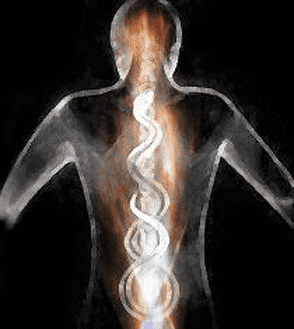
Kundalini Energy
Shakti theoretically awakens the sleeping energy of kundalini, a corporal energy situated at the base of the spine, which then enlivens the chakras (energy points) placed at various points along the spine/body and out the top of the head.
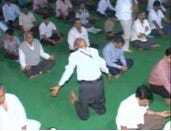
Meditation Kriyas
In Shakti chants, I have personally witnessed and experienced frenzied bodily movements (kriyas) where the body moves without a conscious effort on the part of the owner, real-life moments of an awareness that does not exist in the physical plane, but in some construct of mind or consciousness, the intangible arenas that are as real (to my mind) as the chair I’m sitting in.
In my own experience, I did not invite or expect an explosion in my stomach, which then traveled up through my spine and out the top of my head or the events that happened thereafter. When I spoke of these events to a swami at the ashram, I expected him to be surprised, as if this had never happened to anyone but me.
Instead, he casually explained it as a common occurrence or kriyas among people in the vicinity of a powerful guru, much like the loa jumping from one person to another — also, reminiscent of Deren’s story about “a man standing on the sidelines […] who keels over […] the loa can come like this, without warning, as a wind” (Deren 255). I wasn’t even in the ashram when my events or kriyas happened. I was reading a magazine article about this guru in the comfort of my home miles away.
Some of my genetic ancestors are from the Religious Society of Friends or Quakers. Derisively called Quakers, the word “quaker” is how outsiders described what the Friends did while meditating in silence, their way to personally receive the “indwelling Spirit of God” without the aid of a priest or ornamental ritual.
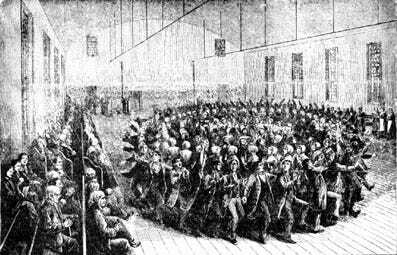
Shaker Dance
Considered devilish in 17th century England, the Quaker belief system incurred the wrath of the King, the Church of England and even The Puritans. (3) “Their intensity of focus sometimes resulted in involuntary physical quaking and weeping” (Larson 19). What these trancelike states have in common is that they are all altered-state experiences of the human mind — altered or theoretical, only in the sense that it is a mode of being that our current science cannot explain, or in some cases, even acknowledge as purposeful events.
The physical bodies and psyches are affected in all these rituals.
Since humans share a common ancestor, it seems plausible that our mental maps, wherever they lead, may also share some similarities in our journey of the mind.
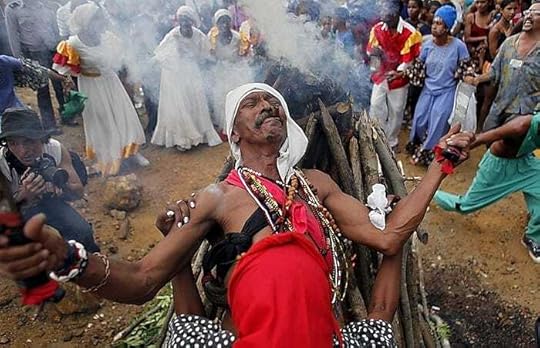
A Santero priest
For those who practice Santeria, “the trance opens the doors to spirit possession, and the gods, or orishas, briefly enter the trance-induced body and use it for earthly advising” (Gage). A sensitive person involved in the ritual dance propelled by the drums willingly becomes possessed or “mounted” on an orisha who can then communicate to the group or answer questions. While in this state the person does not look like himself and talks with the authority of the orisha, (4)“the animating force of his physical body” (Deren 16).
The Haitians have a saying, “When the anthropologist arrives, the gods depart” (Deren xvii), much like the old saying “a watched pot doesn’t boil.” And even though a watched pot does boil, there is a question of how we measure the time it takes to boil and that leads to the woo-woo world in science called quantum mechanics. Quantum mechanics can offer a way to think of these in-between states of circling gods or pre-boiling water, curious events that seem to be affected by the attention, maybe even intention of our thoughts.
I lack the 15 years of mathematics needed to even approach quantum mechanics, a scientific theory that defies the usual rational explanation, but I am not alone in this quantum conundrum. Richard Feynman, a nuclear physicist, famously said, “No one knows why it is that way. That’s just the way it is” (qtd. Sagan 249). Quantum mechanics research shows through repeated experiments that light (and therefore matter) is neither a wave nor a particle until the collapse and this prequel arena, the waiting area for a temporal existence for the light or matter, is what physicists call a state of complementarity.
In his analysis of the relationship between quantum physics (mechanics) and psychology, C. G. Jung noted the synchronicity, especially in the two fields sharing this aspect of complementarity, comparing the unconscious state of the mind before action in the body to the prequel state for matter/light, that arena of neither/nor. In this state of complementarity “the consciousness is once more isolated in its subjectivity” (qtd. in Romanyshyn 32).
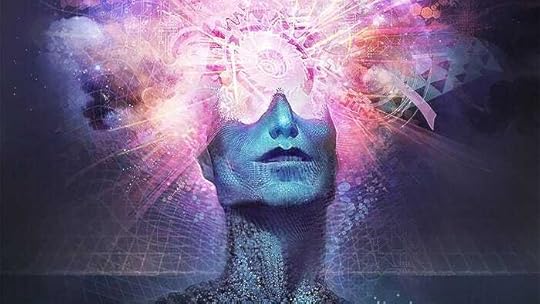
Consciousness is a certainty. Without consciousness, there are no thoughts available to imagine objects and then manifest them in the real world. An architectural draft created in the mind of an architect becomes manifested in the material world with the building of a skyscraper from the draft. We know we have a consciousness, but without tools to measure it in the scientific method, we have no way to prove its existence other than the fact that we know we are thinking, just as I must think the word before I type it. Not typing the word does not mean I didn’t think the word. The word existed as a thought whether or not it exists as a word on a page.
But how do we determine if our thoughts are our own or that of another entity’s thoughts? And how do we prove that thought entities or deities exist without tools to measure them? One way may be to measure the affects on a known object, such as the way astronomers find planets, not by direct observation, but by using the “wobble method” as a way “to track the host star as it is tugged to and fro by the planet’s gravity” (Overbye).
If there is an entire field of science devoted to examining planets not visible to the naked eye, then why shouldn’t thoughtful people examine the possibility of a “fifth dimension” not visible to the naked eye, as well?
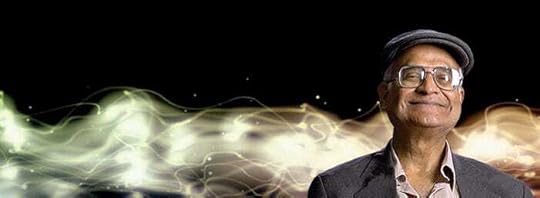 Dr. Amit Goswami
Dr. Amit Goswami“In quantum physics, objects are not determined things — objects are possibilities. Possibilities of what? Possibilities for consciousness to choose from” (Goswami The Quantum Activist). Consider this: in the practice of Santería, the body is the object of a consciousness or an orisha and the body (light) as an object can be possessed by an orisha (wave) from somewhere (which I am arbitrarily calling a fifth dimension), or not possessed but experiencing something (a particle?) in her/his personal space triggered by ritual. The animating influence, whether that of the person animating himself or something “other” animating him in a “fifth dimension,” is an indeterminate by the current laws of science, but nonetheless, the possibility of this animating “other” from somewhere (a fifth dimension?) exists and the proof of that possibility is the affected body of the possessed person like the wobble of a host star.
In quantum mechanics’ experiments, the result of whether light becomes a wave or particle depends on the type of measuring device used, and by comparison, in Santería, the appearance of the gods or orishas depends on the type of measuring minds in attendance and the procedures taken to create the fertile ground to attract the orisha, such as the use of certain colors, candles, chants, rhythms, incantations etc., that are particular to the orisha the group wishes to invite.
For example, Erzúlie or Oshún, the goddess of love expects sacrifices of jewelry, perfume, sweet cakes and liqueurs, and is attracted by the colors gold, pink, blue and white. Philbert Armenteros, an Afro-Cuban musician and Santería practitioner believes the music is not enough to attract a deity, that “the full effect is more likely when all the right elements are present in a ceremony” including the aforementioned items, as well as, a spiritual Santería leader or babalawo” (Gage).
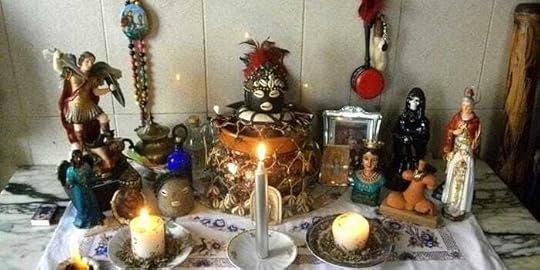
Santaría Altar
Even if it’s something from the “fifth dimension” is it a self-contained entity with a life of its own or is it an energy or color or wave or particle that inhabits a collective unconscious outlined by Jung as a second psychic system of a collective, universal, and impersonal nature,” (Jung, Archetypes 43).
The psychic contents or the orishas animating bodies in Santería rituals could be the inherited collective unconscious of the African experience.
During a Cuban bembe, a sacred style of drumming, Joseph Murphy, a scholar and Santería initiate witnessed a possession, “an altered state of consciousness both in the “horse” of the orisha and in the community in the orisha’s presence” (Murphy 165). “One woman in particular is carried by this energy […] Her eyes are closed, and she is whirling and whirling. […] she falls to the ground. {…} Her eyes are open now and gigantic, their focus open to the whole world. Her face is illuminated with an enormous smile, and she moves her shoulders and hips with sensuous confidence. Oshun has arrived” (96).
This woman had mounted the divine goddess, Oshun. She changed her clothes to gold trappings and moved around the crowd possessed with the mannerisms of the erotic goddess, blowing kisses and laughing. Murphy had already gone through weeks of initiation rites before the event and was very much a sympathetic observer and participant. He looked into the woman’s eyes and was “paralyzed.”

Oshun symbol.
Her sacred peacock.
He wrote “this is not a human being before me. It feels as though the drums are inside my head.” Murphy then experienced “strange sensations and deep calm […] and can see every slap of the drummer’s hands.” He was aware but not alarmed about his voice changing and the unfamiliar words he spoke — African words.
It seemed he had channeled the majestic orisha, Shango. Murphy hyperventilated, but his handlers blew in his ear and calmed him (97). He felt this was “the heart of the religion at last, a harmony of the human and divine in dance and joy” and called this “paradise,” but even after all that he stated “the people have brought the orishas out of themselves” (98) an indication that even after his own close encounter with the god, even then he can only be sure that it came from somewhere inside of himself, origins still unknown. The drum rhythms, the chanting and the dancing seem to be “directly conducive to the state of possession, suggesting the possibility of self-hypnosis as a precursor to the trance state (González-Wippler 8).
After the loa (vodoun) (5) or orisha left the body, the return to reality was accompanied with spasms or jerking movements, but in all the cases the return left the possessed with a new clarity. “How clear the world looks in this first total light” (Murphy 261) — “a call to a new reality” (98). This same description could be applied to an encounter with the angels of Christianity or those who are “born again.”
Depth Psychologist Carl Jung was convinced “the collective unconscious is common to all; it is the foundation of what the ancients called the ‘sympathy of all things’” (Jung, Memories 138). If the “fifth dimension” or the abode of the collective unconscious exists, the nature of this dimension, whether it is a shared area of complementarity, the area of pre-material existence in quantum mechanics or a doorway for unexplainable entities to interact with humans remains a mystery. These experiences of possession in African ritual are too ritualized, too similar, not only among their own African religions of origin, but also with many religious experiences around the world.
The African cosmos (and other rituals) may offer a gateway for studies in the new frontiers of metaphysical dimensions with or without the scientific method — hard for me to say since I’ve subscribed to skeptics.com since forever. Regardless, at the very least, the religions of Africa are a powerful tool. A people so abused, so tortured as African slaves survived unimaginable horrors with the help of this powerful, humanitarian tool: a mystical religion.
And so, I am happy to entertain these ideas and experience the joy of being in the company of a powerful, life-enhancing dynamic, especially with a seemingly golden goddess, either real or imaginary.
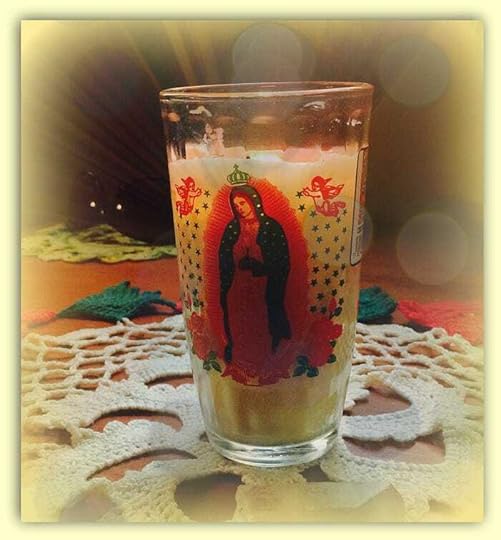
Nuestra Señora de Guadalupe
Notes
(1) In the African Yoruba tradition, there are over 600 orishas or elemental spirits, a complex intricate system of ritual, dance and lifestyle. African religions, of which there are many incarnations on the continent, all share some similarities of a spiritual hierarchy, a monotheistic religion “where secondary divinities, spirits and ancestors provide measured access to sacred power” (Grillo).
(2) Oshun altar found here.
(3)P“Shaking Quakers” in a dance: http://www.utopia-britannica.org.uk/Assets/Shake2.jpg 13 Dec 2012
(4) A Santero priest prays during a ceremony in honor of slaves rebelliousness, as part of the 30th Caribbean Festival in Loma del Cimarron, El Cobre, Cuba. http://news.discovery.com/human/santeria-trance-spirituality-brain.html 12 Dec 2012
(5) Loa is the term for the Haitian deity (Vodoun), which is called an orisha in Santería. Although there may be some cultural differences in names or vevers (sacred symbols), for this discussion of the fifth dimension, loa and orisha are interchangeable. The loa-possessed person transmits energy or even the loa deity to other people with the left hand.
Bibliography
Bourguignon, Erika. “Spirits in Culture, History, and Mind” Journal For The Scientific Study Of Religion 36.3 (1997.
Deren, Maya. Divine Horsemen: The Living Gods of Haiti. NY: McPherson & Co., 2004. Print.
Dyczkowski, Mark. The Doctrine of Vibration: An Analysis of the Doctrines and Practices of Kashmir Shaivism. NY: State U of NYP, 1987. Print.
“Eve.” Encyclopedia of Goddesses and Heroines. Patricia Monaghan. Vol. 1: Africa, Eastern Mediterranean, Asia. Santa Barbara, CA: Greenwood Press, 2010. 85- 86.
Feynman, Richard. Surely You’re Joking Mr. Feynman. NY: Bantam, 1989. Print.
Gage, Julienne. “The Science of Santeria: Do a Little Happy Trance.” http://news.discovery.com/. Discovery.com, 29 Oct. 2009. Web. 16 Dec. 2012.
Gonzalez-Wippler, Migene. Powers of The Orishas. NY: Original Pub., 1992. Print.
Goswami, Amit. God Is Not Dead: What Quantum Physics Tells Us about Our Origins and How We Should Live. VA: Hampton Roads Pub., 2012. Print.
— -. The Quantum Activist. Dirs. Stewart, Ri and Renee Slade. US: Intention Media, 2009. Film.
Grillo, Laura. “African Religions.” Encyclopedia of Women and World Religion. 2 vol. USA: Macmillan Reference, 1999, 6–11.
Jung, C.G. The Archetypes and the Collective Unconscious. NJ: Princeton UP, vol.9:1, 1981. Print.
— -. Jung on Sychronicity and the Paranormal. ed. Roderick Main. NJ: Princeton UP, 2005.
— -. Memories, Dreams, Reflections. USA: Vintage Books, 1989. Print.
— -. The Psychology of Kundalini Yoga. ed. Sonu Shamdasani. NJ: Princeton UP, 1996.
Larson, Rebecca. Daughters of Light: Quaker Women. USA: U of NCP, 2000. Print.
Louchakova, Olga. “Kundalini and Health.” Kundalini Rising: Exploring The Energy of Awakening. Canada: Sounds True, 2009. Print.
Murphy, Joseph M.. Santería: African Spirits in America. Boston: Beacon P., 1992. Print.
Naish, Peter L.N. “Hypnosis And Hemispheric Asymmetry.” Consciousness & Cognition 19.1 (2010): 230–234. Academic Search Premier. Web. 16 Dec. 2012.
Overbye, Dennis. “New Planet in Neighborhood, Astronomically Speaking.” New York Times. 16 Oct 2012, Web. 5 Dec. 2012. <http://www.nytimes.com/2012/10/17/science
Romanyshyn, Robert. The Wounded Researcher: Research with Soul in Mind. New Orleans, LA: Spring Journal, 2007. Print.
Sagan, Carl. The Demon-Haunted World: Science as a Candle in the Dark. NY: Ballantine, 1996. Print.
Shamdasani, Sonu. “Introduction.” C. G. Jung: The Psychology of Kundalini Yoga. ed. Sonu Shamdasani. NJ: Princeton UP, 1996. Print.
Sykes, Bryan. The Seven Daughters of Eve. New York: W. W. Norton & Co., 2001. Print.
Tangaro, Taupouri. Lele Kawa: Fire Rituals of Pele. Honolulu, HI: Kamehameha Press, 2009. Print.
Wells, Spencer. The Journey of Man: A Genetic Odyssey. NJ: Princeton UP, 2002. Print.
(Written in response to Dr. Laura Grillo’s “African and African Diaspora Traditions” Graduate Class Fall 2012 @Pacifica Graduate Institute. Edited for Medium readers.)
March 27, 2025
Floating Up The Yangtze*
*The following is my revision of my non-traditional sonnet, “Lizards Wear Clothes.” I’m updating my Poetry Book for print and this piece seems relevant twenty years later, unfortunately.
The Emperor forgot to wear his clothes.
Constituents fell into clouds of Fools
when steaming golden leeks cooked in the pot
burned black. Heavy water boiled off sticky
temple tangled sentences with empty
words, while lowly interns kissed the Lizards
of crossly Knights. Monkey shouted, “Lizards
get some air and our leader back in cloth!”
Monkey gave up yelling at the empty-
headed lights, floating up the Yangtze. Fools
don’t sense danger as their brains are sticky
cells of grey glop. They smoke a lot of pot,
and anyway, the garden’s gone to pot.
Bunnies chewed the carrots and the Lizards
Back-o-gammoned, while the imps drove sticky
G-cars on a search for royal clothing.
In looking high and riding low, the Fools
spaced out and now the gas tank is empty.
The Naked Monarch screams, “Get me empty
land! We need to piss, Rum; Christ, where’s my pot?”
Rum Man blames the Monkey who blames the Fools
who always blame Bunnies riding Lizards
who eat Cajun AHEEE, wearing silk clothes
from Barneys on Madison. Rum Man sticks
Stiletto Dolls on TV stoking Fools,
then buys the Dolls gold houses made of sticks
and bones—legends from the mist that Lizards
believe. Until the telling time empties
all trash, all waste into the sacred pots,
the Monkey wants the Emperor in clothes
now, before the crispy-fried Fools empty
all the golden pots of sticky treasure
into pockets of Lizards wearing clothes.
© 2004
 Yangtze River
Yangtze River
March 13, 2024
THE CAPTIVE MIND: THEN AND NOW: PART 1
MARY ROWLANDSON was already the captive of a religious cult before the Natives of New England grabbed her during a raid in 1676, she just didn’t know it. 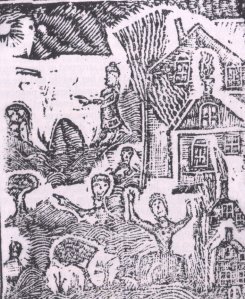 (Woodcut of Rowlandson’s kidnapping. Reprinted in Captive Selves, Captivating Others by Pauline Turner Strong
(Woodcut of Rowlandson’s kidnapping. Reprinted in Captive Selves, Captivating Others by Pauline Turner Strong
Like Mary, I was born into a similar updated version of this cult—three hundred years later (at least burning/hanging witches stopped, for now).
By the time of her abduction during KING PHILIP’S WAR, the beginning of the real end for the sovereignty of New England’s Native People, Mary had lived her forty years in the religious movement called Puritan, so-called by their peers. Puritans professed to lead a life of purity, a life of pure thoughts, a life dedicated to finishing what the Protestant Reformation had started the century before—eliminate any residual popish rituals in the Church of England. Of course, many Englishmen liked their Church just the way it was.
So, Puritans immigrated to America starting with the Mayflower in 1620 to not only escape persecution, but to build a New Jerusalem in a new, pure environment, free to rule their city-on-a-hill without any pesky King or Archbishops to interfere.
Soon after, their hero, OLIVER CROMWELL, seized power with the help of his New Model Army and lobbed off King Charles’ head, but ten years later, Cromwell was dead, and the throne was restored to Charles’ son. In spite of it all, the Puritans of New England forged ahead, and by this time (1660) they outnumbered their Native neighbors by at least three to one. European diseases had killed many Natives, who some ethnographers think numbered 144,000 in New England circa 1600, shrinking to a mere 15,000 by 1620. Entire villages…gone (Page 174).
Puritans modeled their Churches of Christ (Winthrop 264) after the Christian church of the first century following the death of Jesus (at least their vision of what the church was like), a primitive Christianity based on the letters of the Apostles in the Geneva Bible, the preferred version for the English dissenters.
My Church of Christ is a modified version, but still sticking to their patriarchal, misogynistic attempt at a first century model. Of course, any generality is fraught with danger, but a large block of the Republican Party traditionally votes for candidates that favor dictating moral behavior that melded into that old tune of what came to be called manifest destiny.
After all, God is on their side.
Like me, Mary was born into this cult. Mary’s father, Puritan John White, brought his family to New England in 1638 during the Great Migration, when Mary was three, and had moved through the forest to Lancaster about forty miles from Boston around 1652, which at that time was the “vast and desolate wilderness” (Lincoln 132). Mary experienced life through the Bible-tinted glasses of a New England Puritan, a life that was conditioned from birth to believe only the Saints (Puritans) would inherit the Kingdom of God, if they measured up right.
Puritans constantly searched “for clues to God’s purposes” (Fischer 125), and the Natives were obviously sent by the Devil to test their faith. The Puritan Priest, INCREASE MATHER, wholeheartedly agreed with his predecessor and father-in-law, John Cotton. “The conversion of the Indians is not to be expected […] before the conversion of the Jewish Nation” (Mather 4). Cryptic scriptures were dredged up to justify the wholesale slaughter of innocent Native women and children. “I will bring a sword upon you, that shall avenge the quarrel of the Covenant, Leviticus 26:25” (Mather 1). The Bible was their creed, a malleable text to justify their every edict or law, then as now.
In the course of researching my MAYFLOWER genealogy, I stumbled across THE STORY OF MARY BEING WEETAMOO’S SLAVE. In fact, I don’t remember any American history class I took that talked much about the 17th century. The nice Thanksgiving picture with Indians and Pilgrims getting along would dissolve into the next big event—the American Revolution. Not much happened in between, right? Wrong.
The contrast between Weetamoo and Mary Rowlandson could not have been more stark. Weetamoo was born a beloved Queen in her community. Mary was born a wretched sinner and as a woman, a second-class citizen (Fischer 84). Weetamoo was a warrior, Mary was a homemaker (I’m not suggesting this is bad), and the list continues. In the Puritan world women carried then and now the burden of their sex causing the downfall of the entire human race, thanks to Eve’s dalliance with the snake in the Garden of Eden. This event is still taught as fact. And how about the planet being 6012 years old? What’s wrong with you scholars, can’t you add up all the begets in the Bible’s Old Testament?
I was told to ignore what I learned at school. No dancing, no swimming with the opposite sex, no sex for fun, in fact, don’t even mention the word sex. No musical instruments in church. No asking questions.
Puritans censor a wide-ranging selection of words and artistic endeavors, such as literature, art, film, and skinny-dipping.
Mary was unable to see Weetamoo and Natives, in general, as human beings. The Native propensity for nakedness shocked Puritans. Adam and Eve in Genesis were ashamed of their nakedness. Why not these Natives? Native People were wolves, heathens—wicked creatures of the night. Mary didn’t see Weetamoo’s religion or its rituals. She didn’t see their villages as communities, but rather dens of wolves. The natural environment was not a rich, ancient forest, but a “vast and howling wilderness” (Lincoln 134). Puritans, like many Europeans, believed “unicorns lived in the hills, […] mermaids swam in waters, […] tritons played in Casco Bay,” and of course, witches must be burned (Fischer 125). As late as the 18th century, artistic drawings suggest Europeans in general “still had a hard time actually seeing Indians” (Page Centerfold). 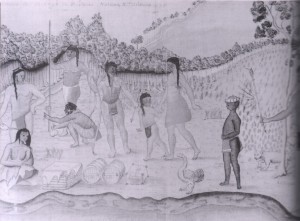 (“Drawing of the Savages of Several Nations.” Alexandre de Batz (1735). Reproduced In The Hands of Great Spirit.” Jake Page.)
(“Drawing of the Savages of Several Nations.” Alexandre de Batz (1735). Reproduced In The Hands of Great Spirit.” Jake Page.)
Mary was eventually ransomed back to her husband and reunited with two of her children. One daughter died during her captivity, but Weetamoo (her children had already died) and what was left of her family died soon after. The Puritans stuck Weetamoo’s head on a pole at Taunton, the site of her ancient homeland. At seeing this head, members of her tribe in the stockade sobbed, “Our Queen…our Queen is dead” (Mather 137).
Mary returned to her Puritan life and was encouraged to write her captivity story, most likely by Mather, who may have written the introduction, perhaps in part to stop any nasty rumors of her defilement (read sex) from the hands of any “savages,” a common problem for any woman returning to Puritan communities from captivity (Strong 101), although rape of English women by Native men was an uncommon occurrence. Of course, if Mary willingly had sexual relations with a Native man, she would have been branded or worse.
MARY’S BOOK also provided a fresh text for Mather and friends to use in the pulpit as propaganda against Native People. 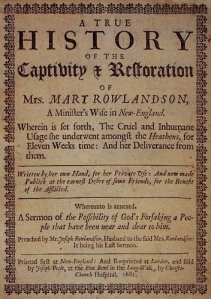 Sometimes even the Bible didn’t frighten the flock as well as a good, scary story in their own backyard, using fear to control people—straight out of the Puritan-like strategy book. Captivity narratives became all the rage after Mary published her book.
Sometimes even the Bible didn’t frighten the flock as well as a good, scary story in their own backyard, using fear to control people—straight out of the Puritan-like strategy book. Captivity narratives became all the rage after Mary published her book.
Now as then, the struggle to think clearly continues.
WORKS CITED
Dillaway, Newton, ed. The Gospel of Emerson. Mass: The Montrose P, 1949.
Winthrop, John. “On Liberty.” 1645. Constitution Society.5 Aug 2008 http://www.constitution.org/
Lincoln, Charles H., ed. Narratives of the Indian Wars 1675 – 1699. New York: Scribner’s Sons, 1913.
Mather, Increase. A Brief History of the Warr with the Indians in New-England (1676). Ed. Paul Royster. Nebraska: U of Nebraska, 2006. 8 Aug 08
Page, Jake. In The Hands of the Great Spirit: The 20,000 -Year History of American Indians. USA: Free Press, 2003.
Philbrick, Nathaniel. Mayflower: A Story of Courage, Community, and War. USA: Penguin, 2007.
Strong, Pauline Turner. Captive Selves, Captivating Others: The Politics and Poetics of Colonial American Captivity Narratives. USA: Westview P, 1999.
More information and links: http://www.conradreeder.com/TheCaptive.htm
Conrad “Connie” Reeder was born in Columbus, Ohio. BA Liberal Arts and a MFA in Film, Theater, & Communication Arts with a concentration in Playwriting.
The Captive is a dramatic play in two acts.
Contact: conradreeder@gmail.com
© All Rights Reserved
February 7, 2024
IF I Ever Bump Into…
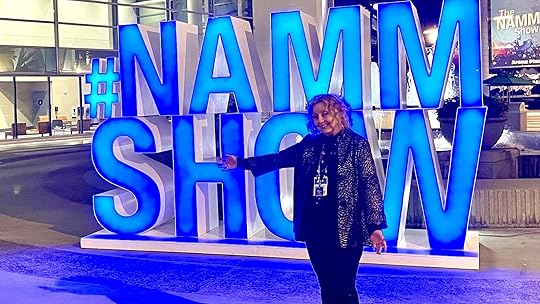
Last week I attended NAMM (National Association of Music Merchants) at the Anaheim Convention Center in Los Angeles with all its explosion of life and music blasting from the stages and booths of 1600+ exhibitors creating a papalooza of sound burgeoning into a riveting cacophony. Horns blowing, guitars shredding, keyboards symphonizing, and vocalists singing or rapping their hearts out to be heard over the ocean of sound. I loved being around so much music even if it was all at once, so alive. I went because I could and because I wanted to be in the room for Mike Lawson’s presentation, “Deconstructing Steely Dan: The Roger Nichols Methods”. Being in a large standing-room-only of people excitedly clapping to Mike’s poignant exploration into the genius of Roger and his integral role in the success of Steely Dan as well as his part in pioneering digital recording was all the reward I needed for the trip but the show had more to give me.
My life continues to be a circuitous journey of synchronicity after synchronicity, especially about bumping into people, famous or otherwise. Like all the times I bumped into Bob Dylan backstage and in the studio, yet somehow never really met him. But who really meets Bob? Then Donald Fagan bought Dylan’s house in Woodstock… Various politicians, no one took pictures, selfies or otherwise, back then. In my circle then and even sometimes now, it’s considered gauche. Okay, tacky.
Then there were times with Stevie Wonder. Once (of many) I was sitting in a chair in the lounge at Soundworks, NY waiting for Roger to finish when Stevie walked in and stood over me in a huge fur with braids flowing, looking every inch like the lion of sound that he is. (The same thing happened with Frank Sinatra, only I nearly feinted from the shock of being next to him.)
But this year at NAMM an entourage leading a blind guy to the down escalator nearly bumped into me as I was trying to get off. I have a gimpy leg, so I am very careful these days and since I was alone, I was paying more attention to not falling as I stumbled around this glob of people.
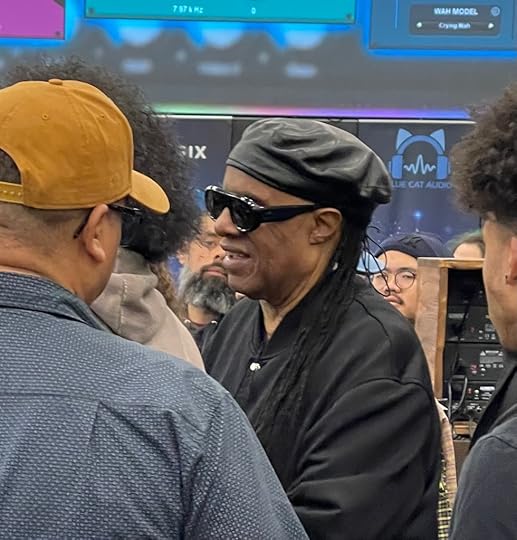
Cut to later as I’m cruising the Main Hall, I see a crowd and there he is: Stevie. Many that consistently go to NAMM know that Stevie usually shows up somewhere. He’s hard to miss with the crowd around him. He was not looking the lion-part and I wouldn’t have even recognized him if I’d looked up during the “almost bump” getting off the escalator.
Unfortunately, a hitchhiker at NAMM called COVID jumped on me and while convalescing at home I looked at Facebook way too much. A thread on a John Denver Fan Club site caught my eye. There is already a lot out there about why didn’t We Are The World organizers invite John? (Which was very ugly of the organizers.) But then someone posted that Stevie felt sorry for John being left out and sent him the demo of a new song, If Ever, for John’s last album on RCA, Dreamland Express.
The part of the story that I know is that engineer Daniel Lazerus was doing something with Stevie and Roger Nichols (my husband and producer of the project) asked Lazerus to ask Stevie IF he had any new songs appropriate for John. He did! John recorded it. If Ever wasn’t a hit, but it happened. John loved that Stevie gave him the song and especially loved that he played harp on the track.
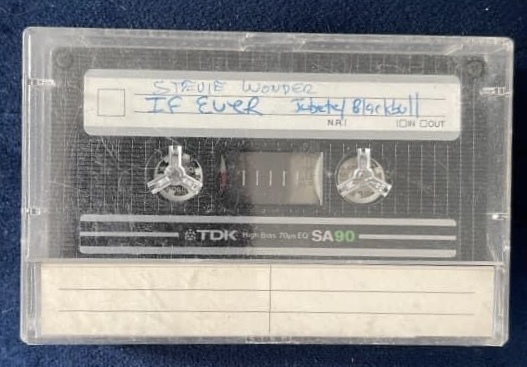
And here it is: Stevie’s cassette demo forty years later. Another one from my dusty desk that ended up in a special box that survived after so many moves, so many that I’ve lost count…like Steely Dan’s Second Arrangement.
IF I ever get to be in the same room with Stevie again, I will wipe off all the germs and happily hand him back his cassette.
August 14, 2023
Lahaina, a Sacred Ground
I believe every square inch of our planet is sacred ground but the fire obliterating Lahaina 8/8 is beyond despair for my family and my Maui Ohana. All the lives lost, all the homes and businesses destroyed. Knowing we can’t go there ever again like it was.
Roger’s ashes are in Maui waters because that’s where we were most happy. After he died, I lived alone on Maui for 10 years with our dog, Charlie, and my heart eventually started beating again with the immensity of Aloha i.e. Love around me.
Donate. Give Aloha. All we have is each other. In the end that’s all that matters. Maui will rise from these ashes. But Lahaina is forever changed. It was always a hallowed ground for the Native Hawaiians, but after this, it is even more sacred with the souls who died in this fire and so many others’ dreams—all in the ashes. 
Maui No ka Oi 
Photo taken by Dave Russell  Roger and me at Lahaina Sound during the China Crisis Project produced by Walter Becker. My vocal credit on the album is Connie Reed. Come on, guys!
Roger and me at Lahaina Sound during the China Crisis Project produced by Walter Becker. My vocal credit on the album is Connie Reed. Come on, guys! 


Me at Maluaka Beach wondering why Native Peoples are so wronged on this planet. Why Roger was treated so badly by people he gave his life’s work for? Why can’t we end a sentence with a preposition? Sigh.

Charlie did not like the 5 hours in cargo to get to Kahului. Such a good boy 
September 26, 2021
The Last Time I Saw JD 1997
Below is a PDF excerpt to finish my thought on the Youtube video where I got cut off talking about the last time I saw John in the flesh. Sorry, but I don’t own the video and I was grateful to get that much. (Thanks, JoLynn Long!)
My book can be found here: Memory Clouds on Amazon
Note: You may have to click on the PDF link to open in your browser or download it.
memory-clouds-last-scene-jdDownloadAll Rights Reserved ©2017
Protected: The Last Time I Saw JD 1997
This post is password protected. You must visit the website and enter the password to continue reading.



